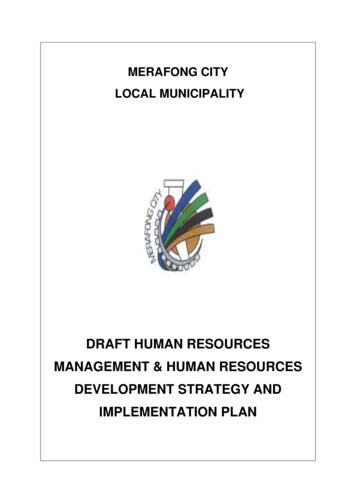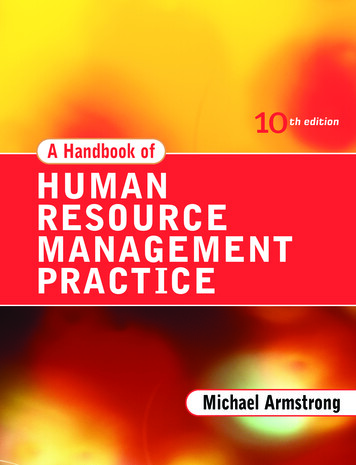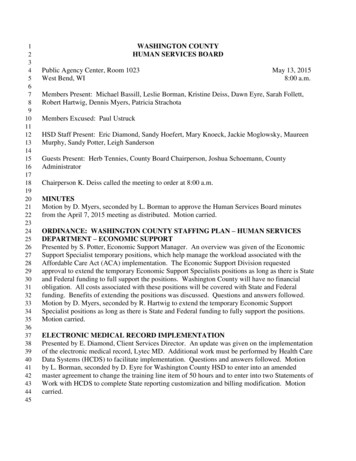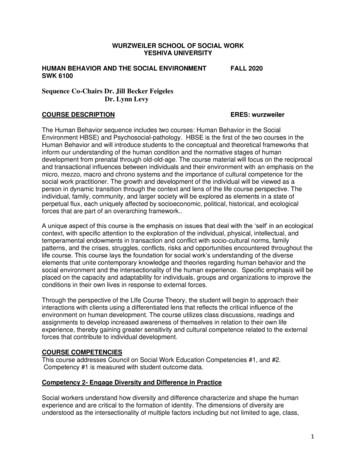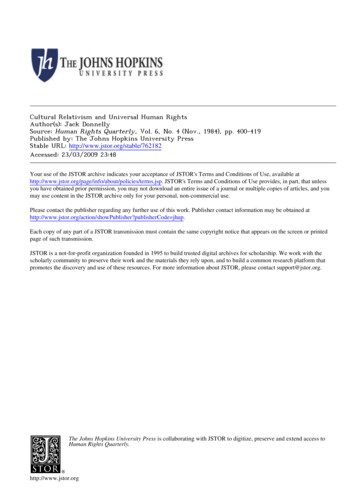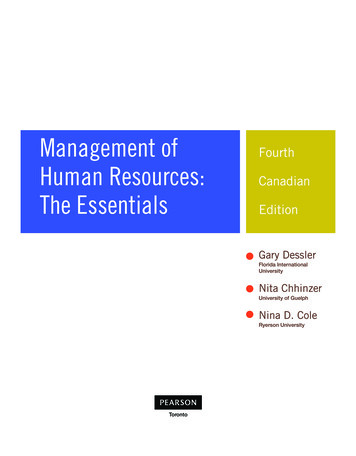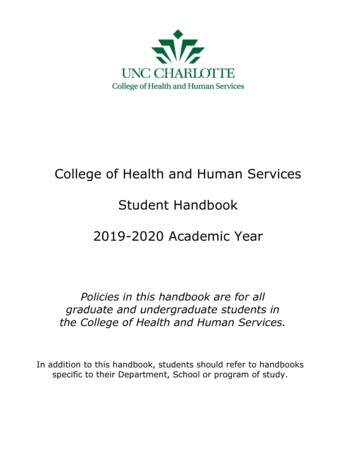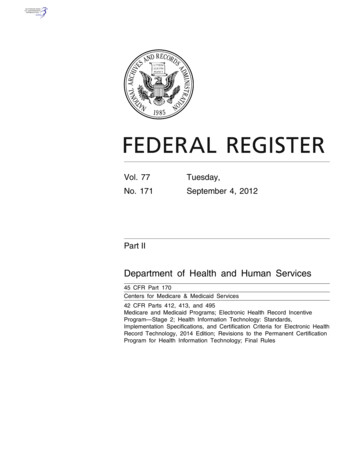
Transcription
Vol. 77Tuesday,No. 171September 4, 2012Part IIDepartment of Health and Human Services45 CFR Part 170Centers for Medicare & Medicaid Servicesmstockstill on DSK4VPTVN1PROD with RULES242 CFR Parts 412, 413, and 495Medicare and Medicaid Programs; Electronic Health Record IncentiveProgram—Stage 2; Health Information Technology: Standards,Implementation Specifications, and Certification Criteria for Electronic HealthRecord Technology, 2014 Edition; Revisions to the Permanent CertificationProgram for Health Information Technology; Final RulesVerDate Mar 15 201018:58 Aug 31, 2012Jkt 226001PO 00000Frm 00001Fmt 4717Sfmt 4717E:\FR\FM\04SER2.SGM04SER2
53968Federal Register / Vol. 77, No. 171 / Tuesday, September 4, 2012 / Rules and RegulationsDEPARTMENT OF HEALTH ANDHUMAN SERVICESCenters for Medicare & MedicaidServices42 CFR Parts 412, 413, and 495[CMS–0044–F]RIN 0938–AQ84Medicare and Medicaid Programs;Electronic Health Record IncentiveProgram—Stage 2Centers for Medicare &Medicaid Services (CMS), HHS.ACTION: Final rule.AGENCY:This final rule specifies theStage 2 criteria that eligibleprofessionals (EPs), eligible hospitals,and critical access hospitals (CAHs)must meet in order to qualify forMedicare and/or Medicaid electronichealth record (EHR) incentive payments.In addition, it specifies paymentadjustments under Medicare for coveredprofessional services and hospitalservices provided by EPs, eligiblehospitals, and CAHs failing todemonstrate meaningful use of certifiedEHR technology (CEHRT) and otherprogram participation requirements.This final rule revises certain Stage 1criteria, as finalized in the July 28, 2010final rule, as well as criteria that applyregardless of Stage.DATES: Effective dates: This final rule iseffective on November 5, 2012, with theexception of the definition of‘‘meaningful EHR user’’ in § 495.4 andthe provisions in § 495.6(f), § 495.6(g),§ 495.8, § 495.102(c), and part 495subpart D, which are effectiveSeptember 4, 2012.Applicability dates: Sections 495.302,495.304, and 495.306 are applicablebeginning payment year 2013.FOR FURTHER INFORMATION CONTACT:Elizabeth Holland, (410) 786–1309, orRobert Anthony, (410) 786–6183, EHRIncentive Program issues orAdministrative appeals process issues.David Koppel, (410) 786–3255, forMedicaid Incentive Program issues.Frank Szeflinski, (303) 844–7119, forMedicare Advantage issues. TravisBroome, (214) 767–4450, Medicarepayment adjustment issues. DouglasBrown, (410) 786–0028, or MariaMichaels, (410) 786–2809 for Clinicalquality measures issues.SUPPLEMENTARY INFORMATION:mstockstill on DSK4VPTVN1PROD with RULES2SUMMARY:AcronymsARRA American Recovery andReinvestment Act of 2009AAC Average Allowable Cost (of CEHRT)VerDate Mar 15 201018:58 Aug 31, 2012Jkt 226001ACO Accountable Care OrganizationAIU Adopt, Implement, Upgrade (CEHRT)CAH Critical Access HospitalCAHPS Consumer Assessment ofHealthcare Providers and SystemsCCN CMS Certification NumberCDS Clinical Decision SupportCEHRT Certified Electronic Health RecordTechnologyCFR Code of Federal RegulationsCHIP Children’s Health Insurance ProgramCHIPRA Children’s Health InsuranceProgram Reauthorization Act of 2009CMS Centers for Medicare & MedicaidServicesCPOE Computerized Provider Order EntryCQM Clinical Quality MeasureCY Calendar YearEHR Electronic Health RecordEP Eligible ProfessionalEPO Exclusive Provider OrganizationFACA Federal Advisory Committee ActFFP Federal Financial ParticipationFFY Federal Fiscal YearFFS Fee-For-ServiceFQHC Federally Qualified Health CenterFTE Full-Time EquivalentFY Fiscal YearHEDIS Healthcare Effectiveness Data andInformation SetHHS Department of Health and HumanServicesHIE Health Information ExchangeHIT Health Information TechnologyHITPC Health Information TechnologyPolicy CommitteeHIPAA Health Insurance Portability andAccountability Act of 1996HITECH Health Information Technology forEconomic and Clinical Health ActHMO Health Maintenance OrganizationHOS Health Outcomes SurveyHPSA Health Professional Shortage AreaHRSA Health Resource and ServicesAdministrationIAPD Implementation Advance PlanningDocumentICR Information Collection RequirementIHS Indian Health ServiceIPA Independent Practice AssociationIT Information TechnologyLOINC Logical Observation Identifiers andCodes SystemMA Medicare AdvantageMAC Medicare Administrative ContractorMAO Medicare Advantage OrganizationMCO Managed Care OrganizationMITA Medicaid Information TechnologyArchitectureMMIS Medicaid Management InformationSystemsMSA Medical Savings AccountNAAC Net Average Allowable Cost (ofCEHRT)NCQA National Committee for QualityAssuranceNCVHS National Committee on Vital andHealth StatisticsNPI National Provider IdentifierNPRM Notice of Proposed RulemakingONC Office of the National Coordinator forHealth Information TechnologyPAHP Prepaid Ambulatory Health PlanPAPD Planning Advance PlanningDocumentPCP Primary Care ProviderPO 00000Frm 00002Fmt 4701Sfmt 4700PECOS Provider Enrollment, Chain, andOwnership SystemPFFS Private Fee-For-ServicePHO Physician Hospital OrganizationPHR Personal Health RecordPHS Public Health ServicePHSA Public Health Service ActPIHP Prepaid Inpatient Health PlanPOS Place of ServicePPO Preferred Provider OrganizationPQRS Physician Quality Reporting SystemPSO Provider Sponsored OrganizationRHC Rural Health ClinicRPPO Regional Preferred ProviderOrganizationSAMHSA Substance Abuse and MentalHealth Services AdministrationSMHP State Medicaid Health InformationTechnology PlanTIN Tax Identification NumberTable of ContentsI. Executive Summary and OverviewA. Executive Summary1. Purpose of Regulatory Actiona. Need for the Regulatory Actionb. Legal Authority for the RegulatoryAction2. Summary of Major Provisionsa. Stage 2 Meaningful Use Objectives andMeasuresb. Reporting on Clinical Quality Measures(CQMs)c. Payment Adjustments and Exceptionsd. Modifications to Medicaid EHRIncentive Programe. Stage 2 Timeline Delay3. Summary of Costs and BenefitsB. Overview of the HITECH ProgramsCreated by the American Recovery andReinvestment Act of 2009II. Provisions of the Proposed Regulationsand Analysis of and Responses to PublicCommentsA. Definitions Across the Medicare FFS,Medicare Advantage, and MedicaidPrograms1. Uniform Definitions2. Meaningful EHR User3. Definition of Meaningful Usea. Considerations in Defining MeaningfulUseb. Changes to Stage 1 Criteria forMeaningful Usec. State Flexibility for Stage 2 ofMeaningful Used. Stage 2 Criteria for Meaningful Use (CoreSet and Menu Set)(1) Discussion of Whether Certain EPs,Eligible Hospitals or CAHs can meet allStage 2 Meaningful Use Objectives GivenEstablished Scopes of Practice(2) EPs Practicing in Multiple Practices/Locations(3) Discussion of the ReportingRequirements of the MeasuresAssociated with the Stage 2 MeaningfulUse ObjectivesB. Reporting on Clinical Quality MeasuresUsing Certified EHRs Technology byEligible Professionals, Eligible Hospitals,and Critical Access Hospitals1. Time Periods for Reporting ClinicalQuality Measures2. Certification Requirements for ClinicalQuality MeasuresE:\FR\FM\04SER2.SGM04SER2
mstockstill on DSK4VPTVN1PROD with RULES2Federal Register / Vol. 77, No. 171 / Tuesday, September 4, 2012 / Rules and Regulations3. Criteria for Selecting Clinical QualityMeasures4. Clinical Quality Measures for EligibleProfessionalsa. Statutory and Other Considerationsb. Clinical Quality Measures for EligibleProfessionals for CY 2013c. Clinical Quality Measures for EligibleProfessionals Beginning With CY 20145. Reporting Methods for Clinical QualityMeasures for Eligible Professionalsa. Reporting Methods for Medicaid EPsb. Reporting Methods for Medicare EPs inCY 2013c. Reporting Methods for Medicare EPsBeginning With CY 2014d. Group Reporting Option for Medicareand Medicaid Eligible ProfessionalsBeginning With CY 20146. Clinical Quality Measures for EligibleHospitals and Critical Access Hospitalsa. Statutory and Other Considerationsb. Clinical Quality Measures for EligibleHospitals and CAHs for FY 20137. Reporting Methods for Eligible Hospitalsand Critical Access Hospitalsa. Reporting Methods in FY 2013b. Reporting Methods Beginning With FY2014c. Electronic Reporting of Clinical QualityMeasures for Medicaid Eligible HospitalsC. Demonstration of Meaningful Use andOther Issues1. Demonstration of Meaningful Usea. Common Methods of Demonstration inMedicare and Medicaidb. Methods for Demonstration of the Stage2 Criteria of Meaningful Usec. Group Reporting Option of MeaningfulUse Core and Menu Objectives andAssociated Measures for Medicare andMedicaid EPs Beginning With CY 20142. Data Collection for Online Posting,Program Coordination, and AccuratePayments3. Hospital-Based Eligible Professionals4. Interaction With Other ProgramsD. Medicare Fee-for-Service1. General Background and Statutory Basis2. Payment Adjustment Effective in CY2015 and Subsequent Years for EPs WhoAre Not Meaningful Users of CEHRT foran Applicable Reporting Perioda. Applicable Payment Adjustments in CY2015 and Subsequent Calendar Years forEPs Who Are Not Meaningful Users ofCEHRTb. EHR Reporting Period for DeterminingWhether an EP Is Subject to the PaymentAdjustment for CY 2015 and SubsequentCalendar Yearsc. Exception to the Application of thePayment Adjustment to EPs in CY 2015and Subsequent Calendar Yearsd. HPSA Bonus Technical Changee. Payment Adjustment Not Applicable toHospital-Based EPs3. Incentive Market Basket AdjustmentEffective in FY 2015 and SubsequentYears for Eligible Hospitals That Are NotMeaningful EHR Users for an ApplicableReporting Perioda. Applicable Market Basket Adjustmentfor Eligible Hospitals Who Are NotMeaningful EHR Users for FY 2015 andSubsequent FYsVerDate Mar 15 201018:58 Aug 31, 2012Jkt 226001b. EHR Reporting Period for DeterminingWhether a Hospital is Subject to theMarket Basket Adjustment for FY 2015and Subsequent FYsc. Exception to the Application of theMarket Adjustment to Hospitals in FY2015 and Subsequent FYsd. Application of Market BasketAdjustment in FY 2015 and SubsequentFYs to a State Operating Under aPayment Waiver Provided by Section1814(B)(3) of the Act4. Reduction of Reasonable CostReimbursement in FY 2015 andSubsequent Years for CAHs That Are NotMeaningful EHR Usersa. Applicable Reduction of Reasonable CostPayment Reduction in FY 2015 andSubsequent Years for CAHs That Are NotMeaningful EHR Usersb. EHR Reporting Period for DeterminingWhether a CAH Is Subject to theApplicable Reduction of Reasonable CostPayment in FY 2015 and SubsequentYearsc. Exception to the Application ofReasonable Cost Payment Reductions toCAHs in FY 2015 and Subsequent FYs5. Administrative Review Process ofCertain Electronic Health RecordIncentive Program DeterminationsE. Medicare Advantage OrganizationIncentive Payments1. Definition (§ 495.200)2. Identification of Qualifying MAOrganizations, MA–EPs and MAAffiliated Eligible Hospitals (§ 495.202)3. Incentive Payments to Qualifying MAOrganizations for Qualifying MA EPsand Qualifying MA-Affiliated EligibleHospitals (§ 495.204)a. Amount Payable to a Qualifying MAOrganization for Its Qualifying MA EPsb. Increase in Incentive Payment for MAEPs Who Predominantly FurnishServices in a Geographic HealthProfessional Shortage Area (HPSA)4. Avoiding Duplicate Payments5. Payment Adjustments Effective in 2015and Subsequent MA PaymentAdjustment Years (§ 495.211).6. Reconsideration Process for MAOrganizationsF. Revisions and Clarifications to theMedicaid EHR Incentive Program1. Net Average Allowable Costs2. Eligibility Requirements for Children’sHospitals3. Medicaid Professionals ProgramEligibilitya. Calculating Patient VolumeRequirementsb. Practices Predominately4. Medicaid Hospital Incentive PaymentCalculationa. Discharge Related Amountb. Acute Care Inpatient Bed Days andDischarges for the Medicaid Share andDischarge- Related Amountc. Hospitals Switching States5. Hospital Demonstrations of MeaningfulUse—Auditing and Appeals6. State Flexibility for Stage 2 ofMeaningful Use7. State Medicaid Health InformationTechnology Plan (SMHP) andPO 00000Frm 00003Fmt 4701Sfmt 470053969Implementation Advance PlanningDocument (IAPD)a. Frequency of Health InformationTechnology (HIT) ImplementationAdvanced Planning Document (IAPD)Updatesb. Requirements of States TransitioningFrom HIT Planning Advanced PlanningDocuments (P–APDs) to HIT IAPDsIII. Waiver of Delay in Effective DateIV. Collection of Information RequirementsA. ICR Regarding Demonstration ofMeaningful Use Criteria (§ 495.6 and§ 495.8)B. ICRs Regarding Qualifying MAOrganizations (§ 495.210)C. ICRs Regarding State Medicaid Agencyand Medicaid EP and Hospital Activities(§ 495.332 Through § 495.344)V. Regulatory Impact AnalysisA. Statement of NeedB. Overall ImpactC. Anticipated Effects1. Overall Effectsa. Regulatory Flexibility Analysis andSmall Entities(1) Number of Small Entities(2) Conclusionb. Small Rural Hospitalsc. Unfunded Mandates Reform Actd. Federalism2. Effects on Eligible Professionals, EligibleHospitals, and CAHsa. Background and Assumptionsb. Industry Costs and Adoption Ratesc. Costs of EHR Adoption for EPsd. Costs of EHR Adoption for EligibleHospitals3. Medicare Incentive Program Costsa. Medicare Eligible Professionals (EPs)b. Medicare Eligible Hospitals and CAHsc. Critical Access Hospitals (CAHs)4. Medicaid Incentive Program Costsa. Medicaid EPsb. Medicaid Hospitals5. Benefits For All EPs and All EligibleHospitals6. Benefits to Society7. General Considerations8. Summary9. Explanation of Benefits and SavingsCalculationsD. Accounting StatementE. ConclusionRegulations TextI. Executive Summary and OverviewA. Executive Summary1. Purpose of Regulatory Actiona. Rationale for the Regulatory ActionIn this final rule the Secretary of theDepartment of Health and HumanServices (the Secretary) will specifyStage 2 criteria beginning in 2014 thateligible professionals (EPs), eligiblehospitals, and critical access hospitals(CAHs) must meet in order to qualify foran incentive payment, as well asintroduce changes to the programtimeline and detail Medicare paymentadjustments. Recommendations onStage 2 criteria from the Health ITE:\FR\FM\04SER2.SGM04SER2
53970Federal Register / Vol. 77, No. 171 / Tuesday, September 4, 2012 / Rules and RegulationsPolicy Committee (HITPC), a FederalAdvisory Committee that coordinatesindustry and provider input regardingthe Medicare and Medicaid ElectronicHealth Record (EHR) Incentive Programswere substantially adopted, withconsideration of current program datafor the Medicare and Medicaid EHRIncentive Programs. Our currentprogram data is derived from twosources. First, data elements from theregistration and attestation process ofthose providers who have alreadyregistered and attested to Stage 1 ofmeaningful use. This includesdemographic information about theprovider, the Certified EHR Technology(CEHRT) used by the provider and theirperformance on the meaningful useobjectives and measures. Second, wehave information from thousands ofquestions providers submitted about theEHR Incentive Programs. Thesequestions provide insights into thedifficulties faced by providers and alsointo the areas of the EHR IncentivePrograms that warrant additionalclarification.mstockstill on DSK4VPTVN1PROD with RULES2b. Legal Authority for the RegulatoryActionThe American Recovery andReinvestment Act of 2009 (ARRA) (Pub.L. 111–5) amended Titles XVIII and XIXof the Social Security Act (the Act) toauthorize incentive payments to EPs,eligible hospitals, and CAHs, andMedicare Advantage (MA) organizationsto promote the adoption and meaningfuluse of CEHRT.Sections 1848(o), 1853(l) and (m),1886(n), and 1814(l) of the Act providethe statutory basis for the Medicareincentive payments made to meaningfulEHR users. These statutory provisionsgovern EPs, Medicare Advantage (MA)organizations (for certain qualifying EPsand hospitals that meaningfully useCEHRT), subsection (d) hospitals andcritical access hospitals (CAHs)respectively. Sections 1848(a)(7), 1853(l)and (m), 1886(b)(3)(B), and 1814(l) ofthe Act also establish downwardpayment adjustments, beginning withcalendar or fiscal year 2015, for EPs, MAorganizations, subsection (d) hospitalsand CAHs that are not meaningful usersof CEHRT for certain associatedreporting periods.Sections 1903(a)(3)(F) and 1903(t) ofthe Act provide the statutory basis forMedicaid incentive payments. (Thereare no payment adjustments underMedicaid). For a more detailedexplanation of the statutory basis for theEHR incentive payments, see the Stage1 final rule (75 FR 44316 through44317).VerDate Mar 15 201018:58 Aug 31, 2012Jkt 2260012. Summary of Major Provisionsa. Stage 2 Meaningful Use Objectivesand MeasuresIn the Stage 1 final rule we outlinedStage 1 meaningful use criteria, wefinalized a separate set of core objectivesand menu objectives for EPs, eligiblehospitals and CAHs. EPs and hospitalsmust meet the measure or qualify for anexclusion to all 15 core objectives and5 out of the 10 menu objectives in orderto qualify for an EHR incentivepayment. In this final rule, we maintainthe same core-menu structure for theprogram for Stage 2. We are finalizingthat EPs must meet the measure orqualify for an exclusion to 17 coreobjectives and 3 of 6 menu objectives.We are finalizing that eligible hospitalsand CAHs must meet the measure orqualify for an exclusion to 16 coreobjectives and 3 of 6 menu objectives.Nearly all of the Stage 1 core and menuobjectives are retained for Stage 2. The‘‘exchange of key clinical information’’core objective from Stage 1 was reevaluated in favor of a more robust‘‘transitions of care’’ core objective inStage 2, and the ‘‘Provide patients withan electronic copy of their healthinformation’’ objective was removedbecause it was replaced by a ‘‘viewonline, download, and transmit’’ coreobjective. There are also multiple Stage1 objectives that were combined intomore unified Stage 2 objectives, with asubsequent rise in the measurethreshold that providers must achievefor each objective that has been retainedfrom Stage 1.b. Reporting on Clinical QualityMeasures (CQMs)EPs, eligible hospitals, and CAHs arerequired to report on specified clinicalquality measures in order to qualify forincentive payments under the Medicareand Medicaid EHR Incentive Programs.This final rule outlines a process bywhich EPs, eligible hospitals, and CAHswill submit CQM data electronically,reducing the associated burden ofreporting on quality measures forproviders. EPs will submit 9 CQMs fromat least 3 of the National QualityStrategy domains out of a potential listof 64 CQMs across 6 domains. We arerecommending a core set of 9 CQMsfocusing on adult populations with aparticular focus on controlling bloodpressure. We are also recommending acore set of 9 CQMs for pediatricpopulations. EPs should report on theserecommended CQMs if they arerepresentative of their clinical practiceand patient population. Eligiblehospitals and CAHs will submit 16CQMs from at least 3 of the NationalPO 00000Frm 00004Fmt 4701Sfmt 4700Quality Strategy domains out of apotential list of 29 CQMs across 6domains. For the Medicare EHRIncentive Program, EPs, eligiblehospitals, and CAHs in their first yearof demonstrating meaningful use mustsubmit their CQM data via attestation,and those beyond their first year mustsubmit their CQM data electronicallyvia a CMS-designated transmissionmethod. For EPs, this includes anaggregate electronic submission or apatient-level electronic submissionthrough the method specified by thePhysician Quality Reporting System(PQRS) that would provide onesubmission for credit in both the PQRSand Medicare EHR Incentive Program.For eligible hospitals and CAHs, thisincludes an aggregate electronicsubmission or a patient-level datasubmission through the method similarto the Medicare EHR Incentive ProgramElectronic Reporting Pilot, which isproposed for extension in the CY 2013Hospital Outpatient ProspectivePayment System (OPPS) proposed rule(July 30, 2012, 77 FR 45188). Forelectronic submissions, patient-leveldata must be submitted using theQuality Reporting Data Architecture(QRDA) Category I format, andaggregate-level data must be submittedusing the QRDA Category III format.c. Payment Adjustments and ExceptionsMedicare payment adjustments arerequired by statute to take effect in2015. We are finalizing a process bywhich payment adjustments will bedetermined by a prior reporting period.Therefore, we specify that EPs andeligible hospitals that are meaningfulEHR users in 2013 will avoid paymentadjustment in 2015. Also, if suchproviders first meet meaningful use in2014, they will avoid the 2015 paymentadjustment, if they are able todemonstrate meaningful use at least 3months prior to the end of the calendar(for EPs) or fiscal year (for eligiblehospitals) and meet the registration andattestation requirement by July 1, 2014(for eligible hospitals) or October 1,2014 (for EPs).We also are finalizing exceptions tothese payment adjustments. This finalrule outlines four categories ofexceptions based on (1) the lack ofavailability of internet access or barriersto obtaining IT infrastructure; (2) a timelimited exception for newly practicingEPs or new hospitals that will nototherwise be able to avoid paymentadjustments; (3) unforeseencircumstances such as natural disastersthat will be handled on a case-by-casebasis; and (4) (EP only) exceptions dueto a combination of clinical featuresE:\FR\FM\04SER2.SGM04SER2
Federal Register / Vol. 77, No. 171 / Tuesday, September 4, 2012 / Rules and Regulationslimiting a provider’s interaction withpatients or, if the EP practices atmultiple locations, lack of control overthe availability of CEHRT at practicelocations constituting 50 percent ormore of their encounters.d. Modifications to Medicaid EHRIncentive ProgramWe are expanding the definition ofwhat constitutes a Medicaid patientencounter, which is a requiredeligibility threshold for the MedicaidEHR Incentive Programs. We includeencounters for individuals enrolled in aMedicaid program, including Title XXIfunded Medicaid expansion encounters(but not separate Children’s HealthInsurance Programs (CHIPs)). We alsospecify flexibility in the lookback periodfor patient volume to be over the 12months preceding attestation, not tied tothe prior calendar year.We are also making eligibleapproximately 12 additional children’shospitals that have not been able toparticipate to date, despite meeting allother eligibility criteria, because they donot have a CMS Certification Numbersince they do not bill Medicare.These changes would take effectbeginning with payment year 2013.e. Stage 2 Timeline DelayLastly, we are finalizing a delay in theimplementation of the onset of Stage 2criteria. In the Stage 1 final rule, weestablished that any provider who firstattested to Stage 1 criteria in 2011would begin using Stage 2 criteria in2013. This final rule delays the onset ofthose Stage 2 criteria until 2014, whichwe believe provides the needed time forvendors to develop CEHRT. We are alsointroducing a special 3-month EHRreporting period, rather than a full yearof reporting, for providers attesting toeither Stage 1 or Stage 2 in 2014 in orderto allow time for providers toimplement newly certified CEHRT. Infuture years, providers who are not intheir initial year of demonstratingmeaningful use must meet criteria for12-month reporting periods. The 3month reporting period allowsproviders flexibility in their first year ofmeeting Stage 2 without warranting anydelay for Stage 3. This policy isconsistent with CMS’s commitment toensure that Stage 3 occurs on schedule(implemented by 2016).3. Summary of Costs and BenefitsThis final rule is anticipated to havean annual effect on the economy of 100million or more, making it aneconomically significant rule under theExecutive Order and a major rule under53971the Congressional Review Act.Accordingly, we have prepared aRegulatory Impact Analysis that to thebest of our ability presents the costs andbenefits of the final rule. The totalFederal cost of the Medicare andMedicaid EHR Incentive Programsbetween 2014 and 2019 is estimated tobe 15.4 billion (these estimates includenet payment adjustments for Medicareproviders who do not achievemeaningful use in 2015 and subsequentyears in the amount of 2.1 billion). Inthis final rule we have not quantifiedthe overall benefits to the industry, norto EPs, eligible hospitals, or CAHsparticipating in the Medicare andMedicaid EHR Incentive Programs.Information on the costs and benefits ofadopting systems specifically meetingthe requirements for the EHR IncentivePrograms has not yet been collected andinformation on costs and benefitsoverall is limited. Nonetheless, webelieve there are substantial benefitsthat can be obtained by eligiblehospitals and EPs, including reductionsin medical recordkeeping costs,reductions in repeat tests, decreases inlength of stay, increased patient safety,and reduced medical errors. There isevidence to support the cost-savingbenefits anticipated from wideradoption of EHRs.TABLE 1—ESTIMATED EHR INCENTIVE PAYMENTS AND BENEFITS IMPACTS ON THE MEDICARE AND MEDICAID PROGRAMSOF THE HITECH EHR INCENTIVE PROGRAM. (FISCAL YEAR)—(IN BILLIONS)Medicare eligibleMedicaid eligibleFiscal till on DSK4VPTVN1PROD with RULES2B. Overview of the HITECH ProgramsCreated by the American Recovery andReinvestment Act of 2009The American Recovery andReinvestment Act of 2009 (ARRA) (Pub.L. 111–5) amended Titles XVIII and XIXof the Social Security Act (the Act) toauthorize incentive payments to EPs,eligible hospitals, and CAHs, andMedicare Advantage (MA)Organizations to promote the adoptionand meaningful use of CEHRT. In theJuly 28, 2010 Federal Register (75 FR44313 through 44588) we published afinal rule entitled ‘‘Medicare andMedicaid Programs; Electronic HealthRecord Incentive Program,’’ thatspecified the Stage 1 criteria that EPs,VerDate Mar 15 201018:58 Aug 31, 2012Jkt 226001Professionals 2.11.81.20.2 0.10.0 1.91.90.60.1 0.2 0.2eligible hospitals, and CAHs must meetin order to qualify for an incentivepayment, calculation of the incentivepayment amounts, and other programparticipation requirements (hereinafterreferred to as the Stage 1 final rule). (Fora full explanation of the amendmentsmade by ARRA, see the Stage 1 finalrule (75 FR 44316).) In that final rule,we also detailed that the Medicare andMedicaid EHR Incentive Programs willconsist of 3 different stages ofmeaningful use requirements.For Stage 1, CMS and the Office of theNational Coordinator for HealthInformation Technology (ONC) workedclosely to ensure that the definition ofmeaningful use of CEHRT and thePO 00000Frm 00005Fmt 4701HospitalsSfmt 4700 0.60.40.50.50.10.0Professionals 0.50.80.80.70.70.5 5.104.903.101.500.500.30standards and certification criteria forCEHRT were coordinated. Current ONCregulations may be found at 45 CFR part170.For Stage 2, CMS and ONC againworked together to align our regulations.In the March 7, 2012 Federal Register(77 FR 13698), we published a proposedrule that specified the potential Stage 2criteria that EPs, eligible hospitals, andCAHs would have to meet in order toqualify for Medicare and/or MedicaidEHR incentive payments (hereinafterreferred to as the Stage 2 proposed rule).In addition, the proposed rule —(1)proposed payment adjustments underMedicare for covered professionalservices and hospital services providedE:\FR\FM\04SER2.SGM04SER2
53972Federal Register / Vol. 77, No. 171 / Tuesday, September 4, 2012 / Rules and Regulationsby EPs, eligible hospitals, and CAHsfailing to demonstrate meaningful use ofCEHRT and other program participationrequirements; and (2) proposed therevision of certain Stage 1 criteria, aswell as criteria that apply regardless ofstage.In the April 18, 2012 Federal Register(77 FR 23193), we published adocument that corrected typographicaland technical errors in the March 7,2012 Stage 2 proposed rule.Simultaneously in the March 7, 2012Federal Register (77 FR 13832), ONCpublished its notice of proposedrulemaking titled Health InformationTechnology: Standards, ImplementationSpecifications, and Certification Criteriafor Electronic Health RecordTechnology, 2014 Edition; Revisions tothe Permanent Certification Program forHealth Information Technology. Thenotice of proposed rulemaking proposedrevisions to the initial set of standards,implementation specifications, andcertification criteria in ONC’s July 28,2010 final rule as well as the adoptionof new standards, implementationspecifications, and certification criteria.We urge those interested in this finalrule to also review the ONC final ruleon standards and implementationspecifications for CEHRT. Readers mayalso visit http://www.cms.hhs.gov/EHRincentiveprograms and http://healthit.hhs.gov for more informationon the efforts at the Department ofHealth and Human Services (HHS) toadvance HIT initiatives.mstockstill on DSK4VPTVN1PROD with RULES2II. Provisions of the ProposedRegulations and Analysis of andResponses to Public CommentsWe received approximately 6,100items of timely correspondence inresponse to our Stage 2 proposed rulepublished in the March 7, 2012 FederalRegister. We received some commentsthat were outside the scope of theproposed rule and therefore are notaddressed in this final rule. Summariesof the timely public comments that arewithin the scope of the Stage 2 proposedrule and our responses to thosecomments are set forth in the varioussections of this final rule under theappropriate headings. We havegenerally organized those sections bystating our proposals, summa
2. Meaningful EHR User 3. Definition of Meaningful Use a. Considerations in Defining Meaningful Use b. Changes to Stage 1 Criteria for Meaningful Use c. State Flexibility for Stage 2 of Meaningful Use d. Stage 2 Criteria for Meaningful Use (Core Set and Menu Set) (1) Discussion of Whether Certain EPs, Eligible Hospitals or CAHs can meet all

